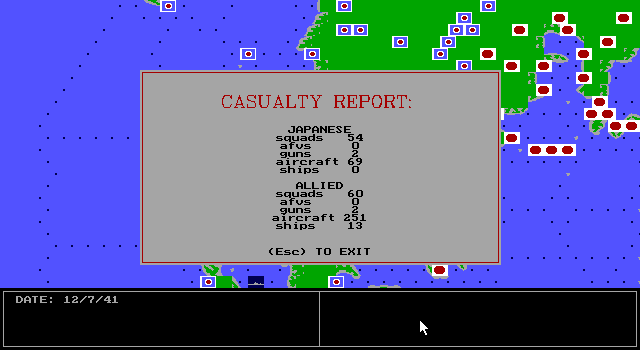Retro Replay Review
Gameplay
Gary Grigsby’s Pacific War delivers an unparalleled strategic sandbox for fans of World War II simulations. From the outset, players must balance the complex interplay of naval, air, and ground forces across the vast expanse of the Pacific and Southeast Asia. You’ll find yourself meticulously planning Task Forces, allocating production resources to ships, planes, and ground units, and reacting to enemy moves in real time. Whether you choose to start in 1941 or a later point in the war, the depth of strategic decision-making is staggering.
(HEY YOU!! We hope you enjoy! We try not to run ads. So basically, this is a very expensive hobby running this site. Please consider joining us for updates, forums, and more. Network w/ us to make some cash or friends while retro gaming, and you can win some free retro games for posting. Okay, carry on 👍)
The game’s user interface revolves around a hex-based operational map, allowing granular control over unit movement and combat resolution. You can issue detailed orders—such as naval interceptions, amphibious assaults, and air reconnaissance missions—and watch as the AI executes them with historical authenticity. Logistics and supply lines are just as critical as firepower, forcing you to decide whether to prioritize reinforcing island garrisons, maintaining carrier task forces, or producing the next generation of aircraft.
Replayability is one of Pacific War’s strongest assets. Each side—Allied or Japanese—presents distinct challenges. Playing as the Allies, you manage a sprawling logistical network and slowly build up overwhelming force. As Japan, you must capitalize on early-war momentum, securing vital resources before Allied shipbuilding outpaces you. Multiple difficulty settings and alternate starting dates mean no two campaigns ever feel the same, offering endless opportunities to refine your strategic approach.
Graphics
By modern standards, Pacific War’s visuals are modest, but they serve the gameplay exceptionally well. The core experience is based on a clean, easy-to-read hex grid overlaying a simplified map of the Pacific and Southeast Asia. Unit counters and Task Force icons are distinct and color-coded, making it simple to track multiple fleets and armies at a glance. While there are no flashy 3D animations, the clarity of the presentation allows you to focus entirely on planning your next move.
Map detail is surprisingly thorough given the game’s era. You’ll see individual hexes marked with terrain features—jungles, mountains, and islands—that affect combat and movement. Naval regions and air zones are clearly delineated, helping you visualize supply lines and frontiers. Tooltips and data overlays can show you resource flows, production capacities, and intelligence estimates, adding layer upon layer of strategic information to your decision-making.
One of the more charming aspects of Pacific War’s graphics is the array of status bars and numerical readouts that fill the side panels. Though utilitarian, they give a strong sense of being a wartime theater commander. Numbers representing industrial output, troop readiness, and fuel reserves update in real time, making the user interface feel alive despite its retro aesthetic.
Story
As a grand strategy title, Pacific War doesn’t follow a linear narrative or scripted storyline. Instead, the “story” emerges from your own strategic choices and the evolving theater of war. Your campaigns will see you rewrite history—maybe repelling the Japanese at Midway, or orchestrating a bold island-hopping campaign that cuts Tokyo’s supply lines. Each playthrough crafts its own narrative tension as the balance of power shifts across thousands of nautical miles.
Historical flavor texts and victory conditions lend authenticity to the unfolding drama. Whether you’re tracking the fall of Singapore or organizing a decisive carrier strike in the Coral Sea, the game’s events are grounded in real-world operations. This historical grounding means that even without cutscenes or voiceovers, you’ll feel invested in the ebb and flow of battle, as if you’re reading headline dispatches from the front.
The multiple entry points—ranging from 1941 right before Pearl Harbor to later key junctures—allow you to explore “what if” scenarios. What if Japan delayed its Southern Advance? What if the United States prioritized submarine warfare earlier? These branching paths ensure that your campaign becomes a unique tale of triumphs and setbacks shaped by your strategic vision.
Overall Experience
Gary Grigsby’s Pacific War is a marathon, not a sprint. Expect lengthy play sessions as you micromanage production queues, coordinate joint operations, and respond to AI offensives. For dedicated strategy enthusiasts, this level of detail is a major draw—every decision carries weight, and a single misstep in logistics can turn the tide of war. Patience and a willingness to dive into spreadsheets of data are key to appreciating the game’s full breadth.
Despite its age, Pacific War remains a benchmark for grand strategy in the Pacific Theater. The robust AI, extensive historical scope, and immense strategic freedom combine to create a living war simulation. While beginners may find the learning curve steep, the comprehensive manual and active online communities provide valuable guidance, helping new commanders get up to speed quickly.
In the end, Pacific War is best suited to players who relish long-term planning and macro-level decision-making. If you’re searching for a fast-paced action experience, look elsewhere. But if you want to immerse yourself in the monumental challenge of directing an entire theater of war—balancing production, logistics, and combat across vast distances—Gary Grigsby’s Pacific War stands as an enduring classic that still rewards careful study and bold strategies.
 Retro Replay Retro Replay gaming reviews, news, emulation, geek stuff and more!
Retro Replay Retro Replay gaming reviews, news, emulation, geek stuff and more!









Reviews
There are no reviews yet.